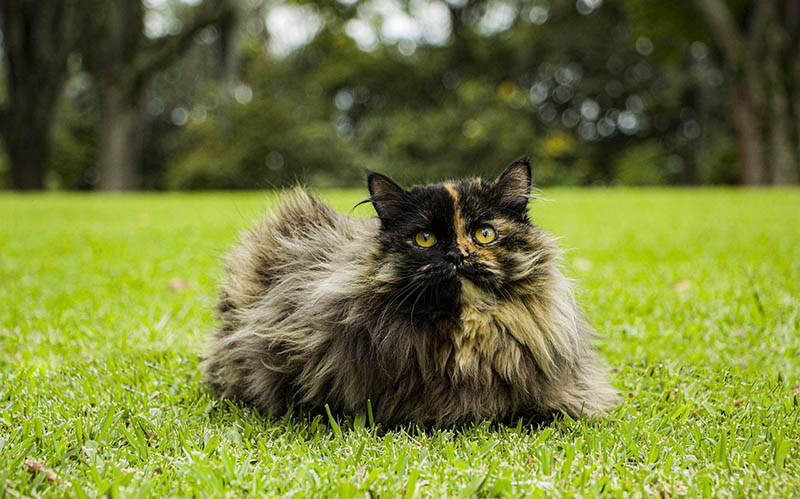If you’re a fan of Persian cats, then you might be familiar with their captivating and unique qualities. But have you ever wondered about the curious and inquisitive nature of Tortoiseshell Persian cats? Tortoiseshell Persians are known for their distinct coat pattern, combining rich tones of black, orange, and cream. But it’s not just their appearance that sets them apart. These feline companions are notorious for their inquisitive nature, always exploring their surroundings and investigating whatever catches their attention. In this article, we’ll take a closer look at the inquisitive nature of Tortoiseshell Persian cats and discover what makes them so curious. But that’s not all – stay tuned till the end for a bonus section where we’ll answer the top 10 most common questions about Persian cats!
The History and Origins of Tortoiseshell Persian Cats
Tortoiseshell Persian cats have a rich history that dates back several centuries. These beautiful felines originated in Persia, which is now known as Iran. The Persian cat breed itself is one of the oldest and most distinguished cat breeds in the world, and the tortoiseshell coat pattern is just one of the many variations seen in this breed.
Origins in Persia
The exact origins of the tortoiseshell Persian cats are somewhat shrouded in mystery, as historical records from that time are scarce. However, it is believed that these cats were prized pets of the nobles and aristocrats in Persia. They were highly regarded for their exquisite beauty and unique coat pattern.
Persian cats, including tortoiseshell Persians, were treasured in ancient Persia and often depicted in artwork, such as paintings and tapestries. The Persian Empire’s trade routes helped spread the breed throughout the world, leading to its popularity in various countries.
Variations in Tortoiseshell Patterns
Tortoiseshell is not a specific breed of cat but rather a coat pattern that can be found in various cat breeds, including the Persian. The tortoiseshell pattern is characterized by a blend of black, orange, and sometimes cream-colored fur. The distribution and intensity of these colors can vary, creating unique patterns on each cat.
Some tortoiseshell Persians have a primarily black coat with small patches of orange and cream, while others may have a more balanced distribution of the three colors. There can also be variations within the tortoiseshell pattern itself, such as brindle tortoiseshell, calico tortoiseshell, and dilute tortoiseshell.
Distinctive Physical Characteristics of Tortoiseshell Persian Cats
Tortoiseshell Persian cats are known for their striking physical appearance. They possess distinct features that set them apart from other cat breeds.
Coat Colors and Patterns
The most obvious physical characteristic of tortoiseshell Persians is their unique coat color and pattern. As mentioned earlier, the tortoiseshell pattern consists of a blend of black, orange, and cream fur. The colors are usually well-distributed across the body, creating a mosaic-like effect.
In addition to the tortoiseshell pattern, some tortoiseshell Persians may also exhibit other coat colors and patterns, such as tabby stripes or white markings. These variations add even more visual interest to their already stunning appearance.
Eye Color and Shape
Another distinctive physical feature of tortoiseshell Persians is their eye color. These cats often have large, expressive eyes that can range in color from green to copper to gold. The eye color complements their coat colors and adds to their overall allure.
As for the shape of their eyes, tortoiseshell Persians typically have round or slightly almond-shaped eyes. This feature enhances their sweet and gentle expression, making them even more captivating to look at.
Body Structure and Size
Tortoiseshell Persians are known for their luxurious and dense coats, which give them a plump and rounded appearance. Their bodies are medium to large in size, with sturdy frames and a well-muscled build. Despite their robust physique, they move with grace and elegance, exhibiting a regal presence.
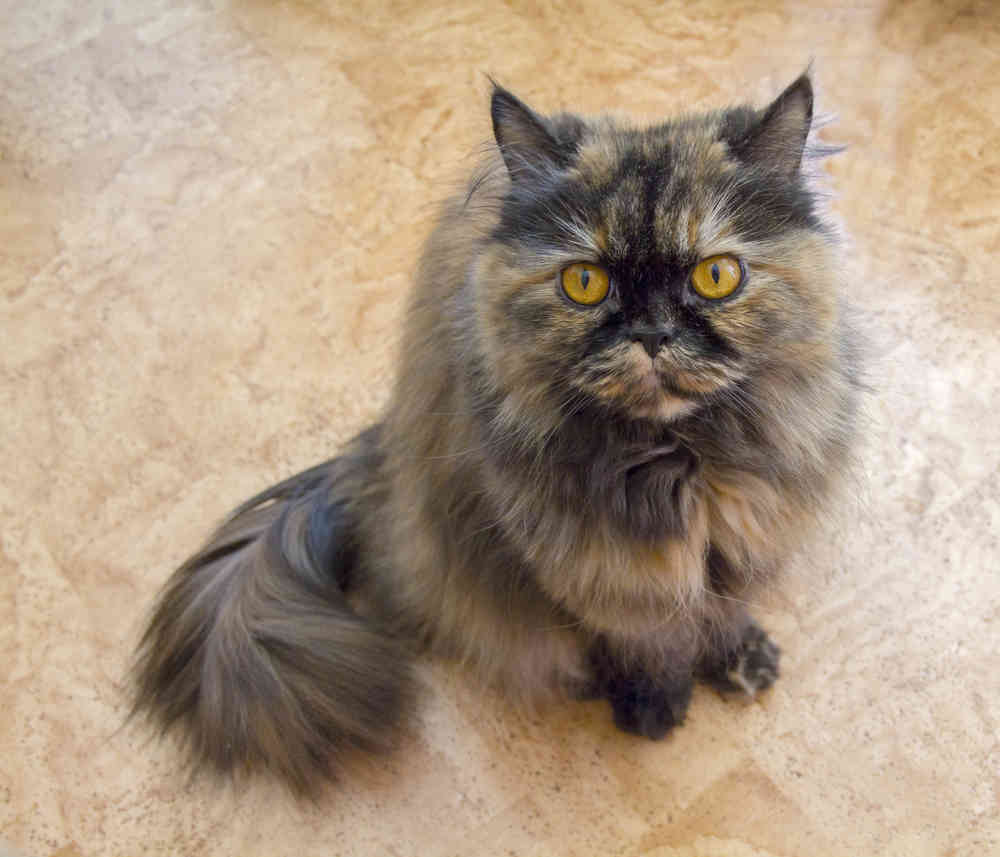
Temperament and Personality Traits of Tortoiseshell Persian Cats
While the physical characteristics of tortoiseshell Persians are undeniably appealing, it’s their temperament and personality that truly set them apart. These cats have a distinct combination of traits that make them beloved companions.
Independent and Assertive Nature
One notable characteristic of tortoiseshell Persians is their independent and assertive nature. They are known for their strong-willed personalities and can be quite opinionated at times. These cats like to do things on their terms and may not appreciate being told what to do.
However, their independent nature also makes them intelligent and self-reliant. They have a natural curiosity and enjoy exploring their surroundings. While they may not always seek constant attention, they appreciate having their own space and personal boundaries respected.
Affectionate and Loving
Despite their independent streak, tortoiseshell Persians are incredibly affectionate and loving towards their human companions. They form strong bonds with their owners and enjoy being in their presence. These cats often seek out cuddles and will happily curl up in their human’s lap for hours on end.
Tortoiseshell Persians have a gentle and nurturing side, often displaying maternal instincts even towards other pets in the household. They enjoy providing comfort and companionship to their loved ones, making them excellent emotional support animals.
Playful and Curious
Tortoiseshell Persians have a playful and curious nature that adds a lively element to their personalities. They enjoy interactive play and can be quite mischievous at times. These cats thrive in an environment that provides mental stimulation and opportunities for exploration.
Their curiosity knows no bounds, and they are known for their penchant for investigating every nook and cranny of their home. Providing them with toys and engaging in playtime sessions helps keep their curious minds occupied and satisfied.
Socialization and Interaction with Tortoiseshell Persian Cats
Tortoiseshell Persians are social cats that enjoy interacting with their human family members and other pets. However, proper socialization is essential to ensure they develop positive relationships and adapt well to different environments.
Bonding with Family Members
Tortoiseshell Persians form strong bonds with their human family members and thrive in a loving and nurturing environment. They appreciate spending quality time with their owners and enjoy being involved in their daily activities.
To foster a strong bond with your tortoiseshell Persian, provide them with opportunities for one-on-one interaction. This can include grooming sessions, playtime, and simply spending time together. Consistency and patience are key to building trust and ensuring a strong bond.
Interaction with Other Pets
Tortoiseshell Persians can generally get along well with other pets, especially if they have been properly socialized from a young age. However, introductions should be done gradually and under controlled circumstances.
If introducing a tortoiseshell Persian to another pet, such as a dog or another cat, it is important to supervise their interactions and provide a safe and neutral space for them to get acquainted. With time and positive reinforcement, they can form harmonious relationships with their furry housemates.
Adapting to New Environments
Tortoiseshell Persians are adaptable cats that can thrive in different environments, as long as their basic needs are met. When introducing them to a new environment, such as a new home or traveling to a new location, it is important to provide a calm and secure environment.
Gradual introductions to new surroundings, along with familiar items such as bedding or toys, can help ease any stress or anxiety they may experience. Their curious nature will eventually take over, and they will explore their new environment with enthusiasm.
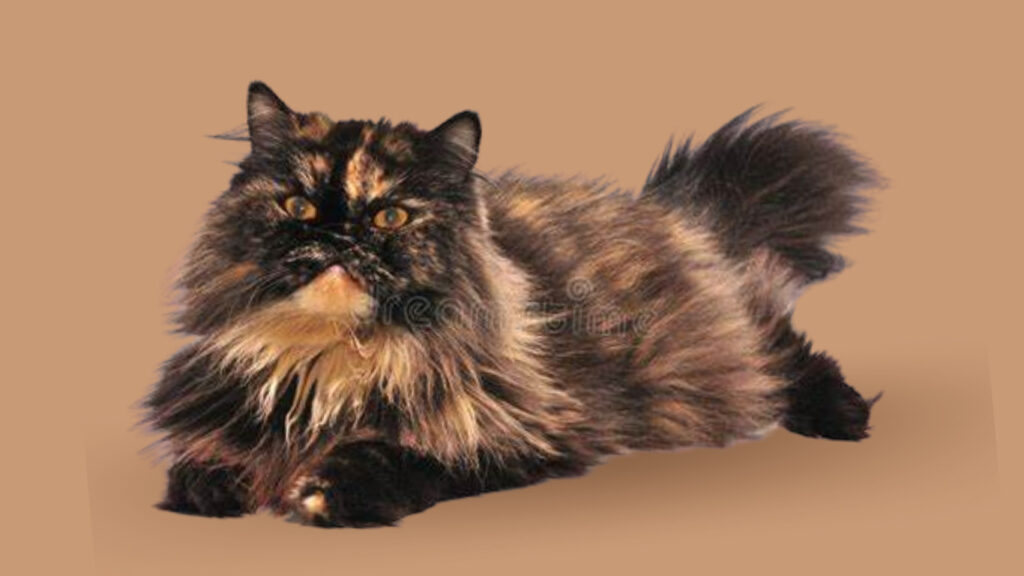
Health and Care Needs of Tortoiseshell Persian Cats
Like any other cat breed, tortoiseshell Persians have specific health and care needs that must be addressed in order to ensure their well-being. Proper grooming, a balanced diet, and routine veterinary care are crucial elements of their overall health care.
Grooming and Coat Maintenance
Tortoiseshell Persians have long, thick coats that require regular grooming to prevent matting and keep them looking their best. Daily brushing is recommended to remove loose fur and prevent tangles or knots from forming.
Bathing should be done on an as-needed basis to keep their coats clean and free from dirt or debris. It is essential to use cat-specific shampoos and to thoroughly dry their coats after bathing to avoid skin irritation.
In addition to regular grooming, routine checks of their ears and nails should be performed to ensure they are clean and trimmed properly.
Diet and Nutrition
A balanced diet is crucial for the overall health and well-being of tortoiseshell Persians. High-quality cat food that meets their nutritional needs should be provided, along with fresh water at all times.
Consult with a veterinarian to determine the appropriate feeding schedule and portion sizes based on your cat’s age, weight, and activity level. Regular monitoring of their weight is important to prevent obesity, which can lead to various health issues.
Common Health Issues to Watch for
Tortoiseshell Persians, like other Persian cats, are prone to certain health issues that can affect their quality of life. Some of the common health problems to watch for include:
- Polycystic kidney disease (PKD): A hereditary condition that can lead to the formation of cysts in the kidneys.
- Brachycephalic airway syndrome: Due to their flat faces, tortoiseshell Persians may have difficulty breathing and be more prone to heat intolerance.
- Eye problems: Persian cats, including tortoiseshell Persians, are susceptible to eye conditions such as entropion (inward rolling of the eyelids) and progressive retinal atrophy (PRA).
- Dental issues: Regular dental care is essential for tortoiseshell Persians to prevent dental diseases such as periodontal disease and tooth decay.
Regular veterinary check-ups are important to catch any potential health issues early and ensure appropriate treatment is provided.
Training and Exercise for Tortoiseshell Persian Cats
While training a cat may not be as straightforward as training a dog, tortoiseshell Persians can still benefit from basic training commands and environmental enrichment. Regular physical exercise also helps keep them mentally and physically stimulated.
Basic Training Commands
Tortoiseshell Persians can be trained to respond to basic commands such as “sit,” “stay,” and “come.” Positive reinforcement techniques, such as using treats or praise, are effective in motivating them to learn and comply with commands.
Short, frequent training sessions are recommended, as cats have short attention spans. Patience and consistency are important when training your tortoiseshell Persian, as they respond best to gentle guidance and positive encouragement.
Environmental Enrichment
Tortoiseshell Persians thrive in an environment that provides mental stimulation and opportunities for exploration. Provide them with a variety of toys, scratching posts, and interactive puzzles to keep them entertained and mentally engaged.
Creating vertical spaces, such as cat trees or shelves, allows them to climb and exercise their natural instincts. Rotating toys and providing new ones regularly prevent boredom and keep their curious minds active.
Physical Exercise Needs
While tortoiseshell Persians are not as energetic as some other cat breeds, they still require regular physical exercise to maintain a healthy weight and overall well-being. Interactive play sessions, such as using a feather wand or laser pointer, can help fulfill their exercise needs.
Engaging in playtime with your tortoiseshell Persian not only provides physical exercise but also strengthens the bond between you and your cat. Aim for several short play sessions throughout the day to ensure they get the exercise they need.
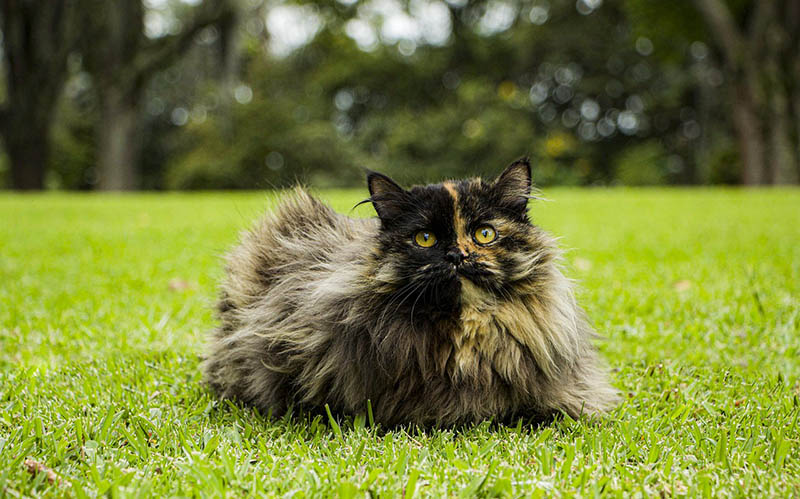
Tortoiseshell Persian Cats as Therapy Animals
The unique temperament and personality traits of tortoiseshell Persians make them well-suited to serve as therapy animals. Their nurturing nature and affectionate personalities can provide comfort and emotional support to those in need.
Traits that Make Them Good Therapy Animals
Tortoiseshell Persians possess several traits that make them excellent therapy animals. Their gentle and loving nature allows them to connect with people on a deep emotional level. They are empathetic and can often sense when someone is in distress or in need of comfort.
Their independent and assertive nature also makes them resilient in challenging or stressful situations, making them suitable for various therapy settings.
Benefits of Therapy Animals for Humans
Therapy animals, including tortoiseshell Persians, provide numerous benefits to humans. Interacting with animals has been shown to reduce stress, lower blood pressure, and improve overall mental well-being. Therapy animals can help individuals feel more relaxed, happy, and socially connected.
Tortoiseshell Persians, with their soothing presence and affectionate personalities, excel in providing emotional support to individuals in hospitals, nursing homes, schools, or any setting that can benefit from their therapeutic presence.
Breeding and Genetics of Tortoiseshell Persian Cats
Understanding the breeding and genetics of tortoiseshell coat color is essential for responsible breeders and those interested in the Persian cat breed.
Inheritance of Tortoiseshell Coat Color
The tortoiseshell coat color is a result of genetics and involves a specific combination of genes. Tortoiseshell cats are almost exclusively female, as the coat color is linked to the X chromosome. Male tortoiseshell cats are extremely rare and typically have an extra sex chromosome (XXY or XYY).
To produce tortoiseshell Persian kittens, a breeder must have a tortoiseshell queen and breed her with a male carrying the orange or “red” gene. This combination allows for the expression of both orange and black fur in the kittens, resulting in the tortoiseshell pattern.
Breeding and Recognized Coat Color Standards
Breeding tortoiseshell Persians is a complex process that requires careful selection of breeding pairs to ensure the desired coat colors and patterns are achieved. Responsible breeders adhere to recognized breed standards set forth by cat associations to maintain the integrity of the breed.
Coat color standards for tortoiseshell Persians may vary slightly between different cat associations. However, the general characteristics of the tortoiseshell pattern, including the blend of black, orange, and cream colors, are consistent across the board.
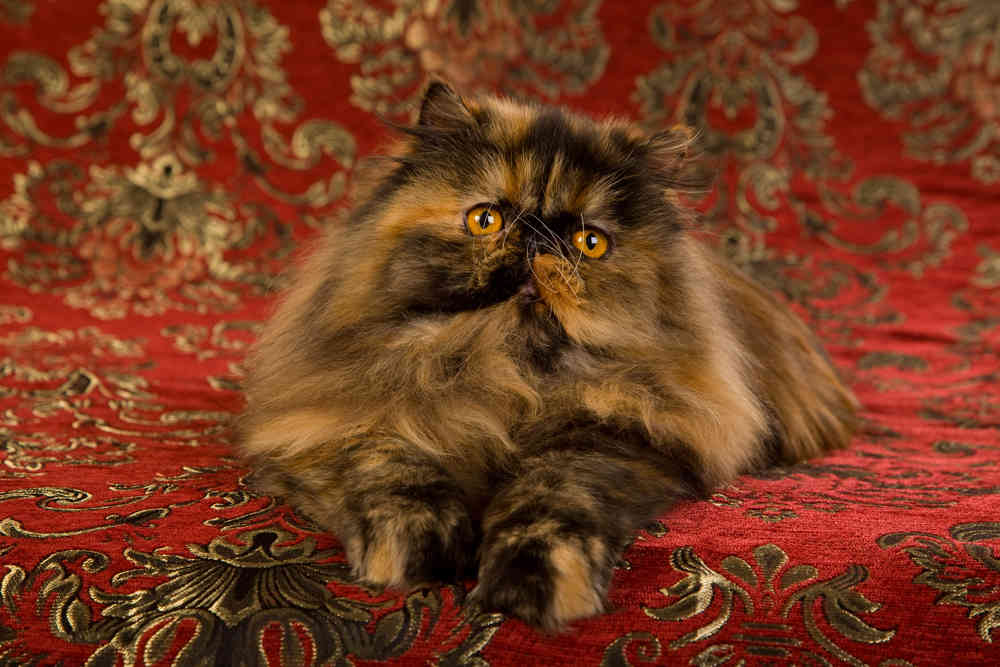
Famous Tortoiseshell Persian Cats in History and Pop Culture
Tortoiseshell Persians have made their mark in history and pop culture, captivating the hearts of many with their beauty and charm.
Celebrity Owners of Tortoiseshell Persians
Several notable celebrities have owned or currently own tortoiseshell Persians, further highlighting their popularity and desirability. From actresses to musicians, these beautiful cats can be seen in the company of some of the most influential people in the entertainment industry.
While privacy concerns may prevent revealing the ownership of specific tortoiseshell Persians, their presence in the lives of celebrities exemplifies the enduring appeal of this unique cat breed.
Tortoiseshell Persians in Literature and Films
Tortoiseshell Persians have also made appearances in various works of literature, films, and television shows. From classic novels to children’s books, their distinctive coat pattern has been described and depicted, captivating readers and viewers alike.
In pop culture, tortoiseshell Persians have been featured in films and television shows, often portrayed as elegant and sophisticated feline characters. These appearances further cement the iconic status of the tortoiseshell Persian cat breed.
Tortoiseshell Persian Cats in Cat Shows and Competitions
Tortoiseshell Persians have enjoyed success in the world of cat shows and competitions, showcasing their beauty and conforming to breed standards.
Breed Standards and Judging Criteria
Cat shows adhere to specific breed standards set forth by recognized cat associations. Tortoiseshell Persians are judged based on their conformation to these standards, which evaluate various aspects such as coat color, pattern, body structure, and eye shape.
Judges assess each cat individually, comparing them to the breed standards, and awarding points based on their adherence to these criteria. Tortoiseshell Persians that exhibit the desired traits and possess the classic tortoiseshell coat pattern are more likely to excel in such competitions.
Notable Achievements by Tortoiseshell Persians
Over the years, there have been many tortoiseshell Persians that have achieved recognition and success in cat shows and competitions. These cats have won numerous awards, titles, and accolades, highlighting the breed’s excellence and beauty.
While specific achievements may vary depending on the individual cat and show, tortoiseshell Persians have consistently proven themselves as contenders in the competitive world of cat shows.
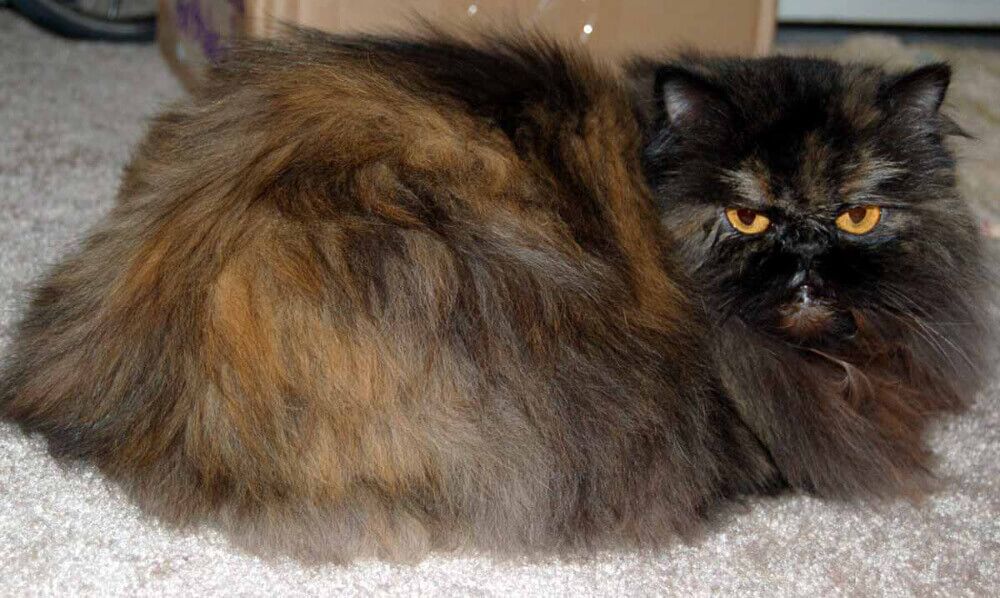
Frequently Asked Questions about Tortoiseshell Persian Cats
Here are answers to some of the most common questions people have about tortoiseshell Persian cats:
Are Tortoiseshell Persians only female?
Tortoiseshell Persians are primarily female, although rare cases of male tortoiseshell Persians do occur. The tortoiseshell coat color is linked to the X chromosome, which is why females are more likely to exhibit this distinctive pattern.
What is the average lifespan of a Tortoiseshell Persian cat?
With proper care and a healthy lifestyle, tortoiseshell Persians can live on average between 12 to 16 years. However, it is not uncommon for some cats in this breed to live into their early twenties with proper veterinary care and a nurturing environment.
Do they require special grooming?
Tortoiseshell Persians have long, luxurious coats that require regular grooming to prevent matting and maintain their appearance. Daily brushing and occasional bathing are recommended to keep their coats in optimum condition.
Are they prone to any specific health issues?
Tortoiseshell Persians, like other Persian cats, are prone to certain health issues such as polycystic kidney disease (PKD), brachycephalic airway syndrome, and eye problems. Regular veterinary check-ups and proper care can help mitigate potential health issues.
Can Tortoiseshell Persians be trained to walk on a leash?
While not all cats enjoy walking on a leash, some tortoiseshell Persians can be trained to walk on a leash with time and patience. It is important to introduce leash training gradually and provide positive reinforcement to encourage them to walk comfortably on a leash.
How do they get their distinctive coat pattern?
The tortoiseshell coat pattern is a result of genetics. Tortoiseshell cats have two X chromosomes, one carrying the black fur gene and the other carrying the orange fur gene. The interaction between these genes creates the mosaic-like blend of black, orange, and cream colors seen in tortoiseshell Persians.
Are Tortoiseshell Persians more prone to certain behavioral traits?
Tortoiseshell Persians are known for their independent and assertive nature, which can sometimes come across as stubbornness. While not all tortoiseshell Persians exhibit these traits, it is important to understand and appreciate their unique personalities.
Are Tortoiseshell Persians suitable for families with children?
Tortoiseshell Persians can be suitable for families with children, especially if they are introduced and socialized from a young age. It is important to teach children how to interact with cats gently and respect their boundaries. Supervision is required to ensure both the cat and children are safe during interactions.
Can Tortoiseshell Persians be left alone for long periods?
Like all cats, tortoiseshell Persians are independent and can tolerate being left alone for moderate periods of time. However, they thrive in a loving and nurturing environment where they receive attention and companionship from their human family members. It is essential to provide them with mental stimulation, toys, and a comfortable environment when left alone.
Do they have any unique dietary needs?
Tortoiseshell Persians do not have any unique dietary needs beyond those of other cats. A balanced and nutritious diet that meets their age and activity level should be provided. Consult with a veterinarian to determine the appropriate feeding regimen for your tortoiseshell Persian.
By understanding the history, physical characteristics, temperament, care needs, and unique aspects of tortoiseshell Persian cats, you can fully appreciate the beauty and charm of this remarkable breed.
